7 places in the US Southwest to see rare 'edge effects' during annular solar eclipse on Oct. 14
If you want to see Baily's beads and a 'broken ring' on Oct. 14, 2023, here's where to go.
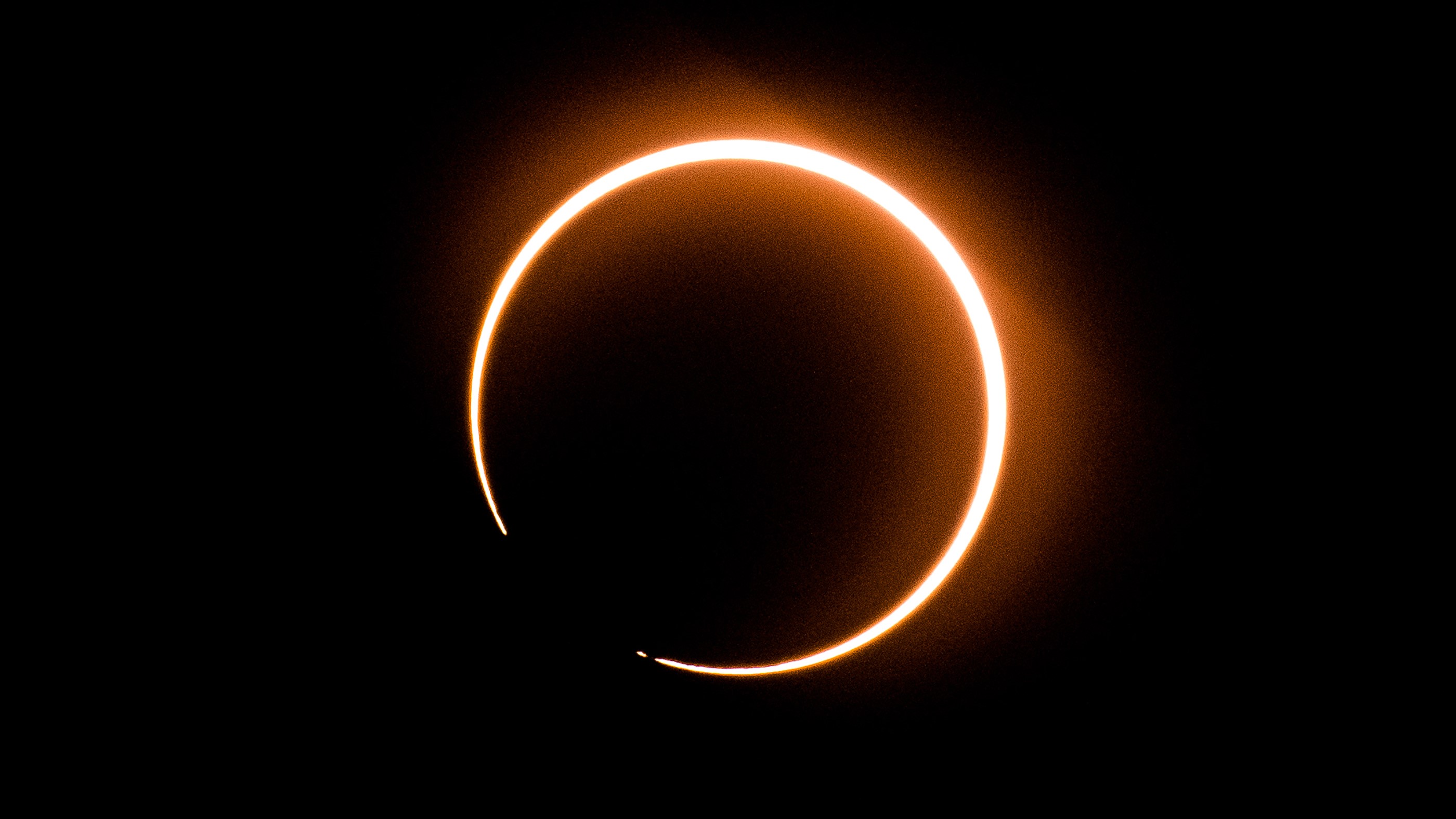
An annular solar eclipse is coming to the Southwest U.S. on Oct. 14, 2023.
If you want to enjoy a "ring of fire" for as long as possible during the October solar eclipse, then head for the centerline of the eclipse path.
However, if you're up for seeing something else equally rare, then going to the centerline may be a mistake.
On the actual day of the eclipse, it may make sense to position yourself at either the southern or northern edge of the path of annularity, where the "ring of fire" is but a fleeting sight, if present at all.
Related: How to watch Oct. 14 'ring of fire' in person and online
Baily's beads and a 'broken ring'
Stand at either the northern or southern limits of the path during an annular solar eclipse and you see not a "ring of fire" but the edge of the moon appearing to touch the edge of the sun — just as you do during a total solar eclipse.
Chiefly, you see a "broken ring" as Baily's beads — sunlight streaming through gaps between the mountains on the moon — fizz around the lunar limb from one side to the other over a few minutes.
You must still wear solar eclipse glasses, or use binoculars and telescopes with solar filters attached at all times during an annular solar eclipse, but the fizzing of Bailey's beads can be quite the sight.
"I saw Baily's beads for a few seconds near the centerline at the 2012 annular through solar-filtered binoculars, and that was the best aspect of that eclipse for me," Michael Zeiler, a solar eclipse cartographer at GreatAmericanEclipse.com, told Space.com. "This October I'm expecting beads for one or two minutes, and it's going to be a striking sight." Zeiler continued.
The illusion of rotation at the edge
There's another reason to stand at the edge of the path during any solar eclipse. "The effect of the edge is really something because of the optical illusion it causes," Mike Kentrianakis, an eclipse chaser famous for his viral video recorded on the Alaska Airlines Solar Eclipse Flight #870 in 2016, told Space.com.
"As the moon crosses the sun it looks like a normal progression until you get to maximum eclipse, and all of a sudden it looks like it stops and turns around," Kentrianakis said.. "The eclipse appears to stop and go the other way!"
This illusion of rotation is a trick your brain plays on you because it lacks reference points to properly place arcs of sunlight as they move around the edge of the moon as the two celestial bodies move independently. "It flipped me out when I saw it in 2017 — it's mind-boggling," Kentrianakis continued. This illusion of rotation occurs at both the southern and northern limits of the path.
Related: October's ring of fire solar eclipse: Top tips for planning your trip
The 'grazing zone'
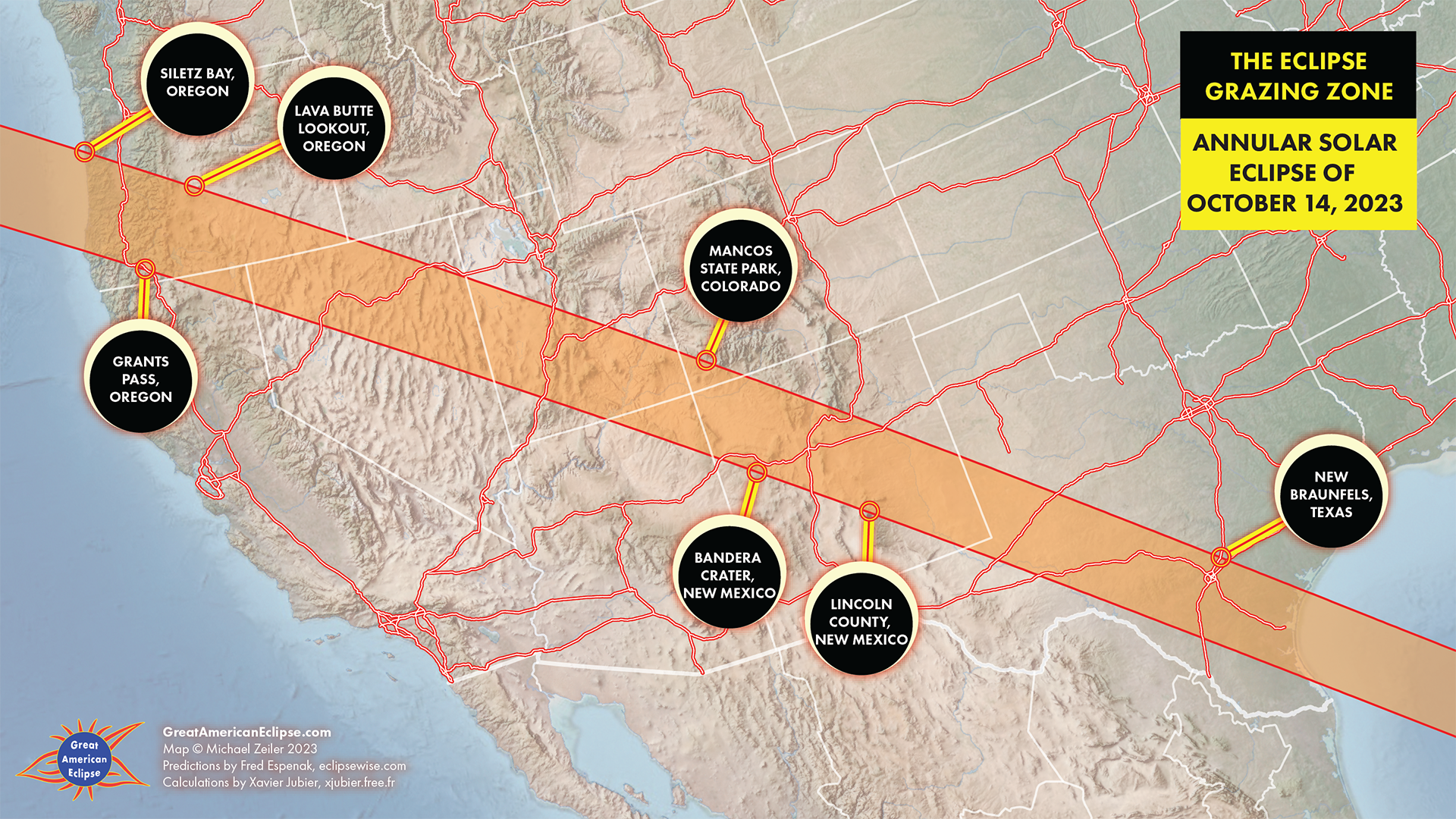
Precision is everything when watching eclipses, but particularly when chasing these "edge effects" because eclipse maps don't actually show where they can be experienced. This interactive map by French eclipse expert Xavier Jubier shows a classically plotted eclipse path, but for any location you click on, a pop-up gives you two durations, one labeled "lunar limb corrected."
In recent years the accuracy of our knowledge of the shape of the moon's profile has hugely increased, largely thanks to NASA's Lunar Reconnaissance Orbiter (LRO). That new data makes it possible to plot the shadow of the mountains and valleys of the moon onto Earth's surface, creating a ragged edge to the path called a "grazing zone." The prize of Baily's beads — and the sight of a "broken" ring that doesn't quite complete — is only visible in this "grazing zone."
"This is the area between the classical limit line and the actual limit line, and it's only about three miles wide," said Zeiler, whose new maps reveal some locations during the annular solar eclipse on Oct. 14, where "edge effects" will be seen.
If you've seen a "ring of fire" before and want to see something different, here are seven places to consider being for the annular solar eclipse to see "edge effects:"
1. Siletz Bay, Oregon
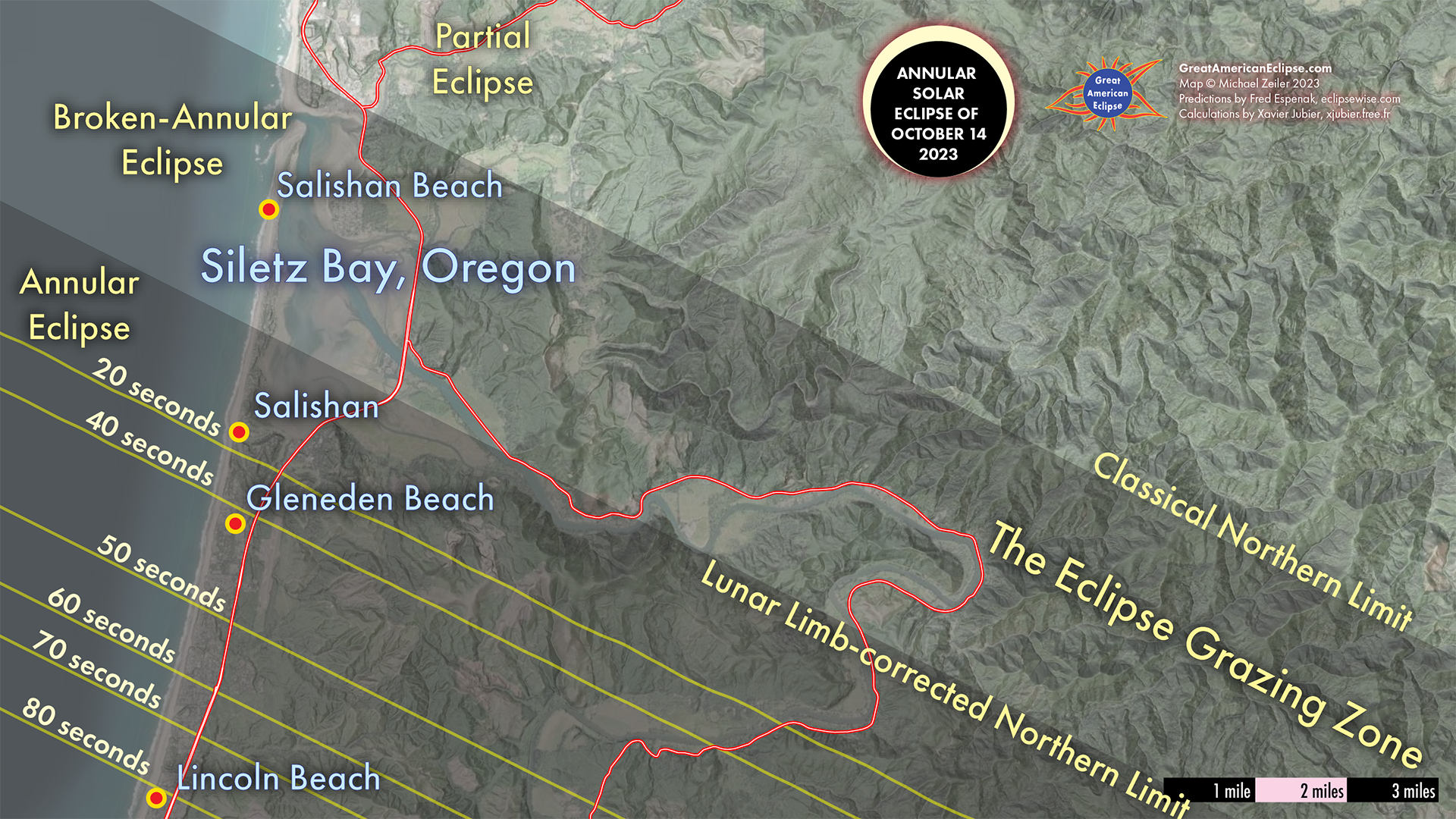
The Oregon coast doesn't have the best chance of a clear sky (there's a 63% chance of cloud, according to Timeanddate.com), but there are other reasons to be on this stretch around Siletz Bay.
Two ideal places to be plumb in the grazing zone for edge effects are Salishan Beach and the Alder Island Nature Trailhead just off Oregon Coast Highway 101. The latter is between Pelican Brewing on the classical northern limit and Beach Crest Brewing on the lunar-limb corrected northern limit. Maximum eclipse will occur 17 degrees up, above some hills, to the southeast at 9:18 a.m. PDT on Oct. 14, 2023.
2. Grants Pass, Oregon
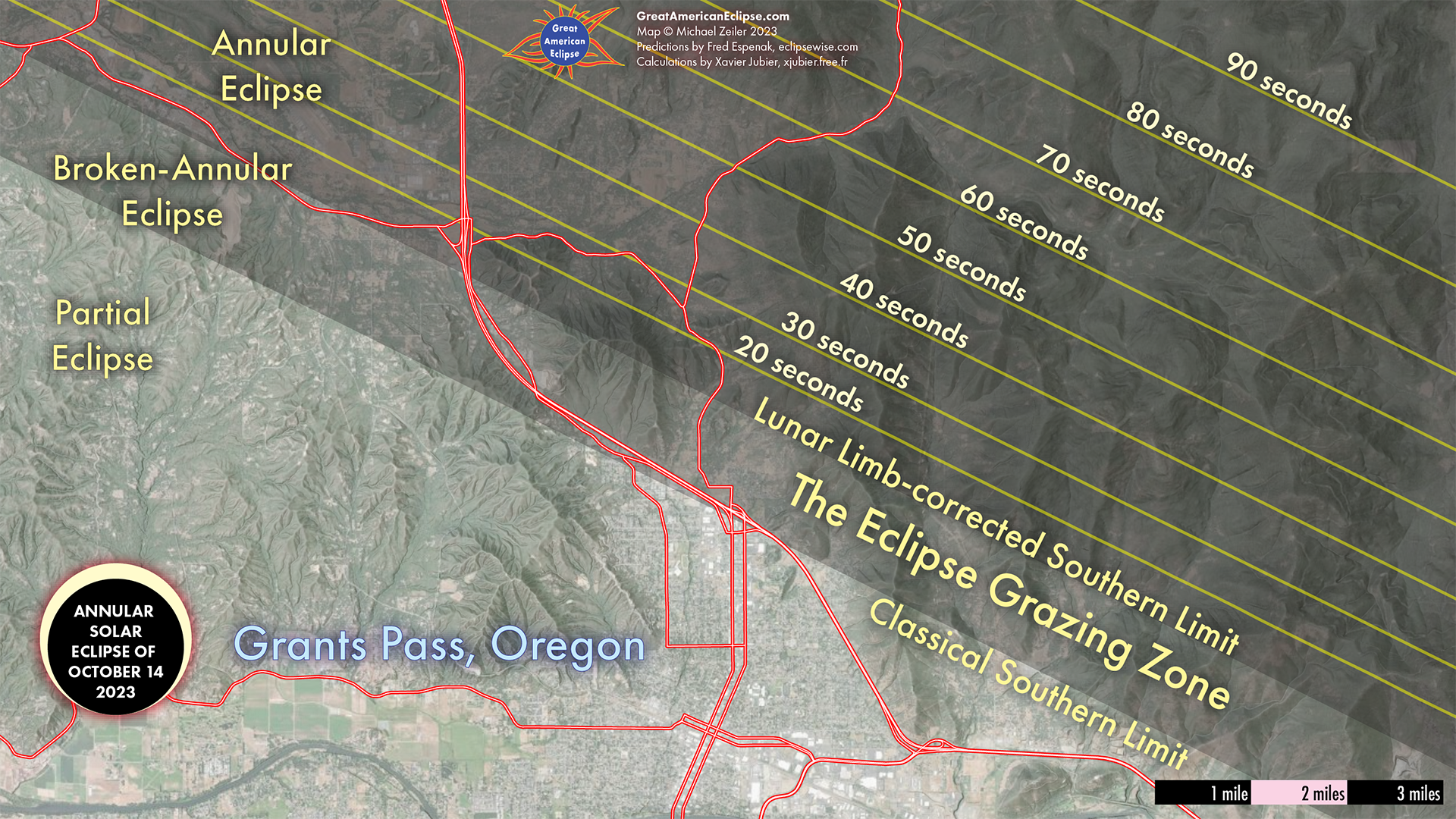
One of the few towns on the edge of the path, this community in the Rogue Valley (population: 40,000) is on Interstate 5 along the Rogue River.
There are plenty of hotels and lodging options here and a 40% chance of cloud on the day, according to Timeanddate.com. Anywhere north of Interstate 5 in the town's northern suburbs will be perfect for edge effects. Maximum eclipse will occur 19 degrees up, above Beacon Hill to the southeast at 9:18 a.m. PDT on Oct. 14.
3. Lava Butte Lookout, Oregon
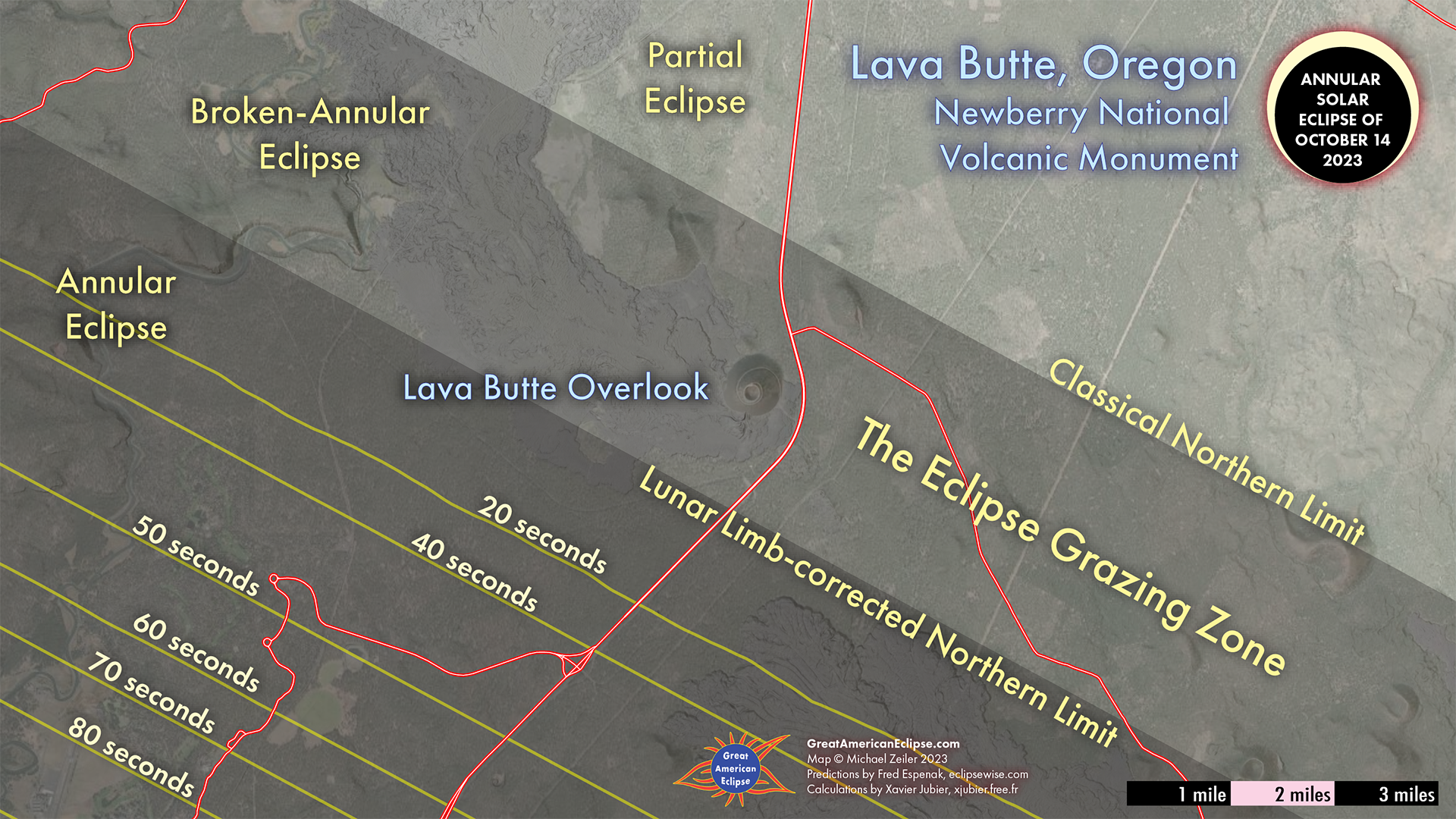
To view a broken annulus above an otherworldly landscape of volcanic buttes, consider heading up to this 500-foot-tall (150 meters) cinder cone. Just off Interstate 80, the butte is accessed via a timed ticket because only about 10 vehicles ($5/vehicle/day) can fit in the parking lot on the cone's rim, around which there's a short walk.
Although the panoramic view is the attraction (with the Three Sisters, Mount Jefferson and Mount Hood to the north), the Lava Lands Visitor Center's Trail of the Molten Land below the butte itself would also make a good viewing area. It's just 13 miles (21 kilometers) south of the beer drinker's paradise of Bend, Oregon.
There's a 45% chance of cloud here on the day, according to Timeanddate.com. Maximum eclipse will occur 19 degrees up, above a butte-dotted landscape to the southeast at 9.19 a.m. PDT on Oct. 14.
Related: What's the difference between a total solar eclipse and an annular solar eclipse?
4. Mancos State Park, Colorado

Here's a great alternative to the bound-to-be-crowded Mesa Verde National Park. Just 14 miles (22.5 km) away, Mancos State Park in southwestern Colorado, off the San Juan Skyway, is circled by the San Juan mountain range, but the peaks won't get in the way of the eclipse.
Aside from its southwestern portion, the reservoir is in the "grazing zone," with the park's West Campground and its nearby trailhead ideal spots. If you love fishing, camping and Baily's beads, then you're in for a treat.
As a bonus, there's just a 30% chance of clouds here on the day, according to Timeanddate.com. Maximum eclipse will occur 33 degrees above the southeast horizon at 10:33 a.m. MDT on Oct. 14.
5. Bandera Crater, New Mexico

In New Mexico's Land of Fire & Ice south of Grants is Bandera Crater, another cinder cone in the path of annularity within a volcanic field located on the Continental Divide. However, from the top of a self-guided trail, there's a fantastic view of a "Chain of Craters" — a line of cinder cones — but to see Baily's beads and a broken ring you'll need to be just to the east on Ice Caves Road. It's all part of the El Malpais National Monument.
There's just a 25% chance of cloud here on the day, according to Timeanddate.com. Maximum eclipse will occur 35 degrees up to the southeast at 10:35 a.m. MDT on Oct. 14.
Related: 10 Earth impact craters you must see
6. Alto, New Mexico
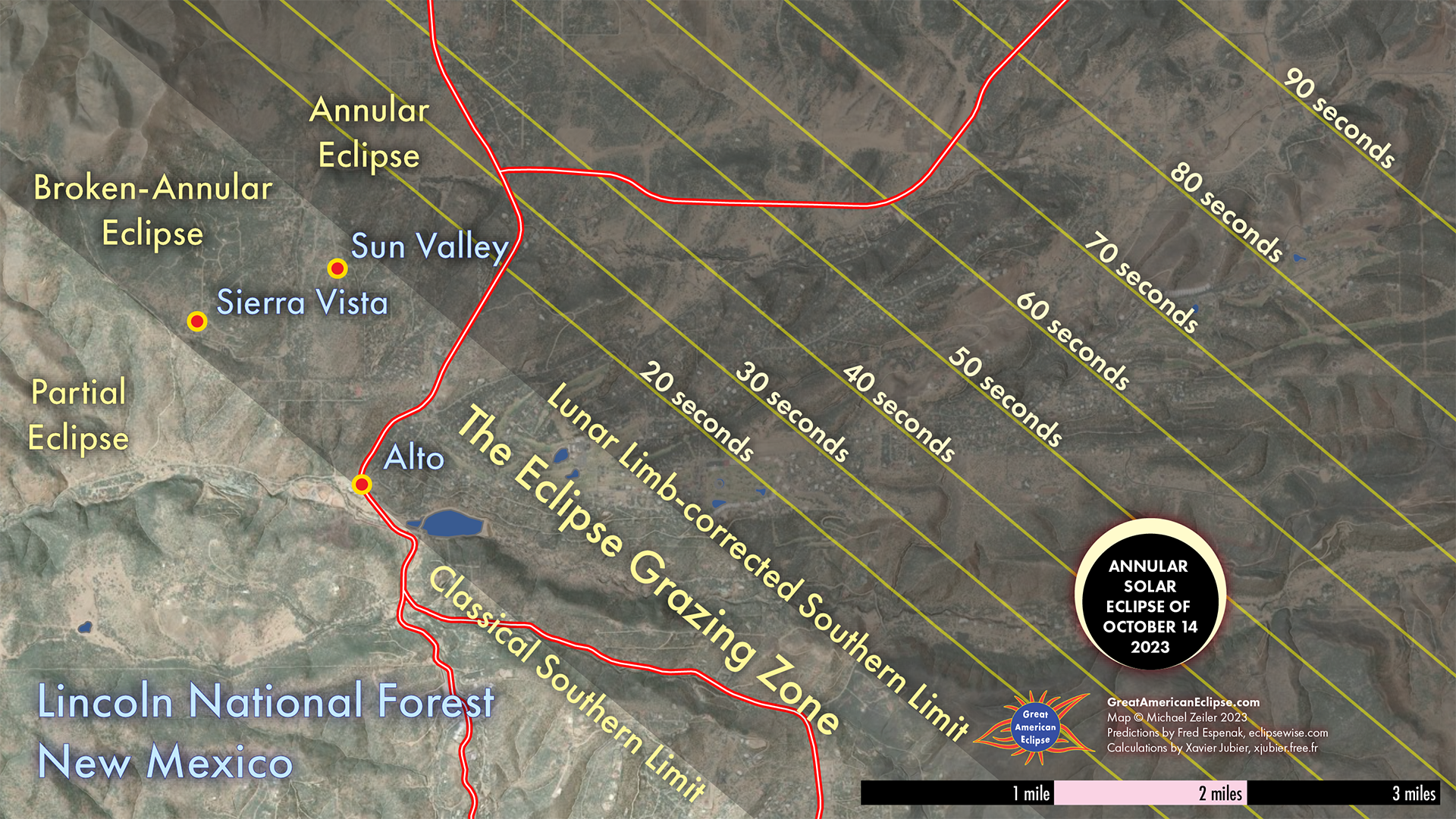
A few miles north of Ruidoso in New Mexico's Lincoln National Forest is the mountain getaway town of Alto where chalets, cabins and vacation rentals abound.
At an elevation of 7,550 feet (2,300 meters) and just a 29% chance of cloud here on the day, according to Timeanddate.com, it could be an excellent venue for edge effects.
A great place to position yourself would be Alto Lake and Recreation Area right off the Billy the Kid Scenic Byway and right on the southern edge of the grazing zone. Maximum eclipse will occur 38 degrees up, above mountains to the southeast, at 10:39 a.m. MDT on Oct. 14.
7. New Braunfels, Texas
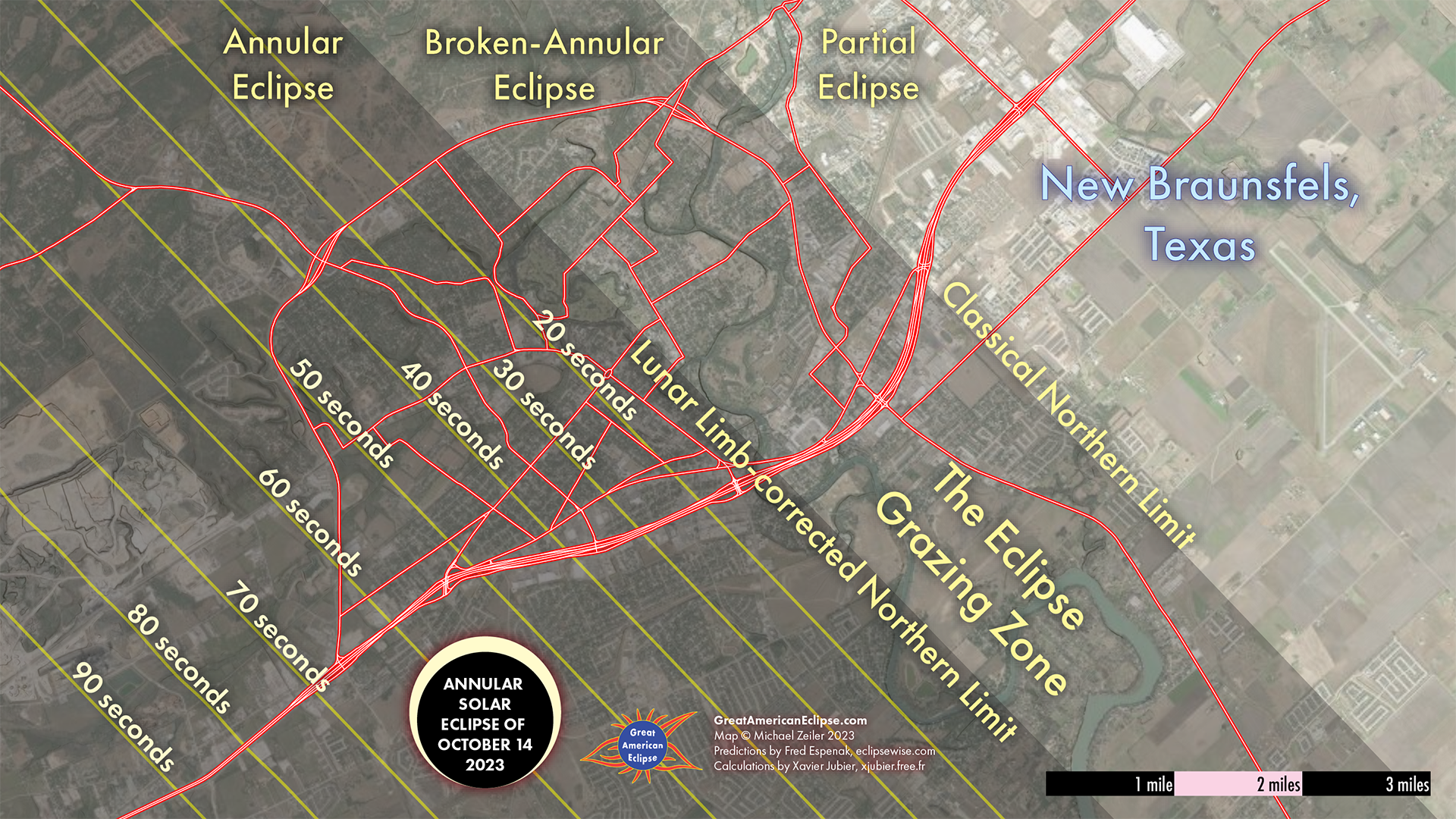
Those after some edge effects on a quick fly-in, fly-out trip could consider either staying in San Antonio and traveling north or staying in Austin and traveling south.
Either way, a good destination might be New Braunfels, whose cluster of superstores at the intersection of Interstate 35 and Highway 46 — such as New Braunfels Home Depot — are perfect for observing from a large parking lot.
There's a 59% chance of cloud here on the day, according to Timeanddate.com. Maximum eclipse will occur 47 degrees above a flat southeast horizon at 11:54 a.m. CDT on Oct. 14.
Join our Space Forums to keep talking space on the latest missions, night sky and more! And if you have a news tip, correction or comment, let us know at: community@space.com.
Get the Space.com Newsletter
Breaking space news, the latest updates on rocket launches, skywatching events and more!

Jamie is an experienced science, technology and travel journalist and stargazer who writes about exploring the night sky, solar and lunar eclipses, moon-gazing, astro-travel, astronomy and space exploration. He is the editor of WhenIsTheNextEclipse.com and author of A Stargazing Program For Beginners, and is a senior contributor at Forbes. His special skill is turning tech-babble into plain English.










